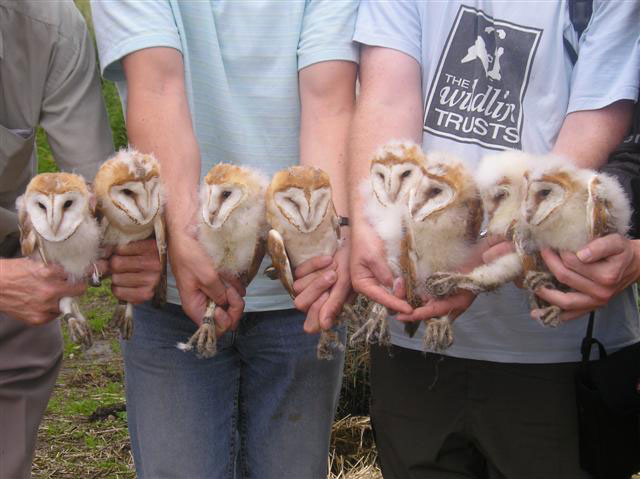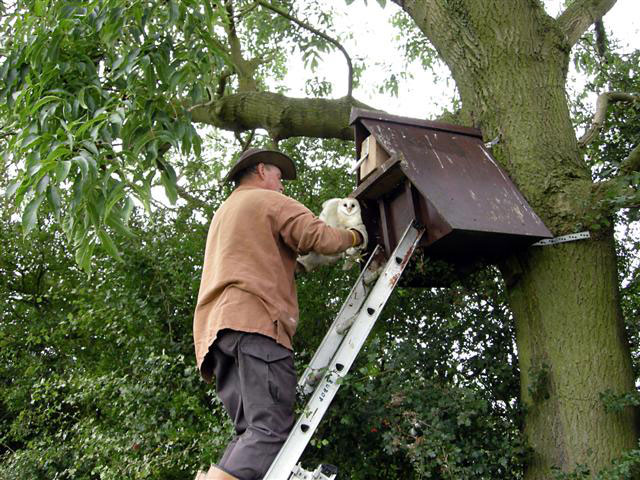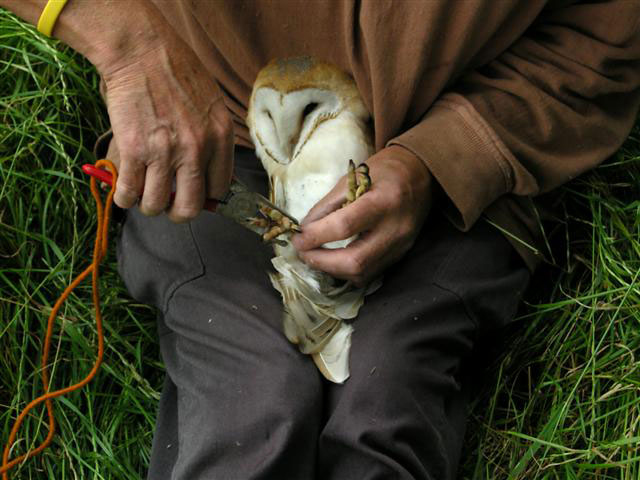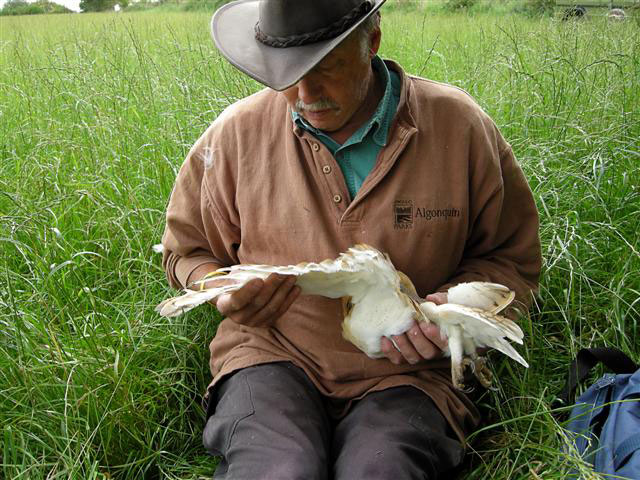
photo: Kate Thompson
Tuesday 24th July
Withdrawal symptoms are kicking in and the rain stops me from getting out. The older chicks should all be flying by now but still roosting in the boxes between taking flying, and hunting, lessons with the adults. Possibly, the adults with the earliest broods could be thinking of laying eggs for a second brood, often in a nearby box while the fledged chicks are still using the natal box.
Earlier in the week, I'd had a phone call from the lady at the farm where the male had drowned and we'd helped with some supplementary feeding. One of the chicks had been picked up dead in the hay barn. Hard to say what happened to it, but sadly, there are always a few casualties.
It was fine this morning, the first rain-free morning of the week, and I went out to check a few boxes. First to the golf course, where we'd ringed six chicks a month ago. There are three boxes here and the first I looked in was the box that had been used to raise six chicks late last year. The box was empty but showed signs of use, probably by a male. Next the natal box: an owl left the box as I approached and I hoped that it was the adult male leaving the female on eggs inside. No such luck but I caught one of the young females inside and there was a couple of uneaten voles, indicating that food was still plentiful.

photo: Ellen Broughton
I thought I'd check the third box while on site and halfway up the ladder, I heard the sinister hissing of what could only be Barn Owl chicks. Opening the door, I saw a female with a lot of chicks. I took her out; she was ringed so I took the ring number and put her in the cat box while I went to count the chicks. There were seven, the eldest about four weeks old. There were also some spare voles so a good chance that they'll all survive. I discovered later that she was the female that I'd ringed in mid-May in the box where I'd mistaken Stock Dove eggs for Barn Owls, which had been my only nest failure of the year. I'd checked this box in mid-May and it had been empty.
Nearby is a farm with a box that had four chicks. I had a peek at these and all four were at home, so I left them to it and moved on to see if the runt in the brood of five I'd ringed on 10th July had survived. It had and it was looking good now that the facial feathers were through and the other flight feathers were showing; its siblings were also still in the box.
Next, a quick look in the box that had produced my first five chicks of the year; there was no-one at home but a couple of fresh voles showed that the box was still in use.
Friday 3rd August
I was pleased to see that the members of the RSPB had voted the Barn Owl their favourite farmland bird. This is no surprise to the devotees of the Barn Owl though to me, it was surprising that the Skylark came second in the poll. No disrespect to the Skylark, it's a better singer than the Barn Owl - but how often have you stopped the car to watch a Skylark?
With most of our chicks now fledged and time to soon to start checking for second broods, we were slightly in limbo so it was a good time to keep our promises to some landowners and put up a few new boxes. Quite close to me is the small village of Owthorpe; pity it's not "Owlthorpe", as a nearby farm has two pairs of Barn Owls nesting.
Close to the village are some medieval fish ponds, long strips of hollows that were mainly overgrown. A local man has been restoring the area for some time, clearing the ponds and planting native trees and some Old English apple trees and it's a haven for birds, butterflies and dragonflies. We'd promised him a box some time ago so this was a good stopgap to fill our time between inspections.
Only Lynne and myself were available but we're well practiced at box erections and with Lynne on the rope and me on the hammer, it was soon up on a tree on the edge of the wood, looking out onto meadowland.
Monday 13th August
I received an email from Jim Lennon this morning saying that he'd been checking boxes as part of the Barn Owl Monitoring Program and that he'd not only found birds on second broods, but also some pairs that were breeding late in boxes that had been empty in May and June. Jim suggested that we check all the boxes again: a big job but necessary if we were to ring all the chicks. A good year suddenly got better.
Meanwhile, Lynne and I had two more boxes to put up, over at Thrumpton Hall where we'd been prospecting a couple of weeks ago. At the Hall, I was introduced to the Lady of the House, the author Miranda Seymour, who is a grand-daughter of the 8th Baron Howard de Walden. She loves owls and was delighted that we were putting up the boxes at the Hall. Nice to have friends in high places!!
Tuesday 21st August
After a hectic Bird Fair, it was nice to be back in action as we started our round of looking for second broods. All of the squad were keen to get out so I had Lynne, Gordon and Richard out to share the work. First we had to ring the late brood of chicks on the golf course. At the last look, there were seven chicks and I had high hopes that we would have a first for Rushcliffe Barn Owl Project (RUBOP). However, it was not to be: one had been "recycled" and we had to be satisfied with six nice chicks.

photo: Ellen Broughton
The next box was one that had already fledged four young and was empty. However, there is another box nearby that has never held anything but Stock Doves and Jackdaws. We went for a quick look, expecting nothing, and found an unringed female with five small chicks on top of a Jackdaw nest. I put a ring on her and she was soon back in the box.
After this pleasant surprise, we moved on to another box that had been used last year but not this. There was a female inside with a newly hatched chick and lots of eggs. We left them in peace and moved on. The next group of boxes were all empty: three boxes close together, one of which has had Little Owls for the last two years. As we checked one box, a Barn Owl flew out from at the back of the tree and a closer inspection revealed a large hole with several pellets. This was probably a young bird, born this year, that had just moved away from the nesting territory. The box nearby also had a few pellets so hopefully it will stick around for next year and use the nice warm box on the other side of the tree.
Tollerton Hall has three boxes, all of which have been used over the years. I went to check the box that had given us five chicks this year and on approaching saw a white face looking out of the box. There had been a runt in the brood and I thought it might be that and, because the bird was near the hole, I used the net and the bird was easily caught. However, it was my turn to be surprised as the bird, a young female, was unringed. I'd already ringed the five chicks here some time before so it was a mystery as to where she was from.
Looking in the box revealed two more birds inside. I took out the first and was alarmed to see that this bird had a badly broken leg. We put it in the cat box and I rang Colin Shawyer for advice. Colin suggested we get the injured bird to a vet. He also suggested that the unringed bird might have seen the others out hunting and followed them back to the box. The third bird in the box was the runt, now fully fledged and in good health.
I took the injured bird home and rang a few vets and ended up at Loughborough, 12 miles away. I left it with them but unfortunately, it died overnight. Strange though that whilst losing one owl, we should gain another!!
Finding the injured bird had curtailed our box inspections for the afternoon so after returning from the vets, I returned to the parkland to check the other boxes. Barn Owls often move boxes for a second brood so it was no surprise when I found the pair in one of the other boxes. The male departed but the female was at home with three chicks and some eggs, so I left her to it.

photo: Ellen Broughton
Wednesday 22nd August
Lynne and Gordon came over and we checked a few of the boxes that had already raised broods. All were empty; all the chicks having fledged, which was good news. A box at Keyworth had been used by Little Owls earlier this year so I was surprised to find a female on eggs. Unusually, she left the box as I went back down the ladder and, on having a second look, I was surprised to find two tiny chicks and eight eggs. I've never had one lay 10 eggs before and it'll be interesting to see how many she can fledge.
Thursday 23rd August
A whole lot of boxes still to do and all the workers busy doing their own thing so a quick call to my niece Gilly who was more than happy to come and help. It's good for my ego to be seen out with a 6ft blonde!!
Anyway, it was mainly a blank morning: nothing in any of the boxes apart from a few pellets in one box, giving hope for the future and even the boxes that had fledged chicks had no 2nd broods.
Over to the east of Nottingham is the beautiful Vale of Belvoir and the village of Langar is probably most famous as a parachuting centre. There's also a Wild Flower Farm here where Gordon and I had erected a pole box last February. This farm has a nice tea shop and I treated Gill to tea and cake (generous to a fault), before driving out to the box. There'd been a couple of cold Kestrel eggs in the box in May so we were surprised when a Barn Owl came out and there were seven small chicks inside. I told the man at the farm the good news and he asked if he could kiss me; I declined and told him we'd be back in a month for the ringing!
Earlier, we'd checked a couple of Wildlife Conservation Partnership (WCP) boxes where I'd earlier ringed broods but both were empty. Back in May, Lynne and I had rehung a WCP box that had fallen off the tree and at the same time had found the Barn Owls nesting in a tree hole where they'd fledged three young. We checked this next and found a female on eggs. She was off the eggs and very feisty but I read her ring number and put her back without losing too much blood, discovering later that she was one that I'd ringed as a chick two years ago.
Friday 24th August
I'd arranged to do the boxes at the old Co-op College, and the ones that I have in Leicestershire, and met the gardener/handyman after he'd finished work. The female was in the breeding box on four eggs so we left her alone and checked the others, where we found a lone roosting female. She was ringed, but not one of ours, so one for the BTO to sort out for us. She was possibly the female that had nested in the tree hole at the front of the Hall.
Onto the boxes in Leics and we went first to the breeding box where I was able to catch the male of the pair. The original male here had been killed on the road back in March so this was a new unringed bird.
From here, we went to the box that had been used for breeding in the last two years and the female was inside on seven eggs.
Tuesday 28th August
My daughter Ellen was staying for the weekend so I took her out to check some boxes. Lucky girl! A good thing about this time of year is that most of the crops are in so you can drive over the stubble to get to the boxes. Some of our earlier boxes were erected in places where you can't usually drive and it can be a real slog carrying the ladder and rest of the kit around the boxes in spring and summer when the crops are in the fields. Nowadays, we try to be a lot choosier about where we hang the boxes and if we don't have easy access, we don't put it up.
We drew a blank as far as breeding was concerned but did find a roosting male that came out of the box, and also caught an unringed female which I ringed.
Thursday 30th August
I had a look at the forum on the website of the Barn Owl Conservation Network and read that in South Lincolnshire, Bob Sheppard and Alan Ball have ringed over 500 Barn Owl chicks and have another 28 pairs on second broods from only a quarter of their regular sites. What an incredible number, which makes our 114 look quite small.
Pole boxes again today so help from Gordon, Nigel, Richard and Clive. First to RCP where the breeding box was empty, but a female came out of the next box, and I found seven eggs in the box. One was just hatching and I was able to help the tiny chick out of the egg. Later, at another box at the far end of the park, two Barn Owls left the box and we found six eggs inside. From here, we went to do the other poles on the farm where we have to bridge the stream; this wasn't nearly as wide as the last time, after the rain, and we were soon across but only a roosting bird was seen here.
Friday 31st August
Getting close to the end of the rechecks today. Gordon came over but the first farm we visited that had three boxes drew a blank. One of the nice things about living in South Notts is the Stilton cheese; we live within six miles of the four creameries that produce this finest of English cheeses so are able to buy directly from them. The next boxes are in a field that belongs to the Cropwell Bishop Creamery.
We'd had a roosting male in one of the boxes last year but the spring inspection had drawn a blank, and opening the door this time revealed a Jackdaw nest. However, we have to show caution with these as we've had Barn Owls nest on top of them in the past. Sure enough, after showing no signs, a Barn Owl tried to leave. I blocked the hole with my hand and she went back in and I was able to take her out before feeling around inside, where I found three chicks and four eggs. She was a ringed bird and I found out later that she was ringed by WCP in North Notts in 2004.
The next farm was the one where we'd found two breeding pairs. One was in a tree hole and one in a box, fledging three and five, so this one farm would have had 12 Barn Owls flying around. Earlier this week, Jim Lennon had found the female from the box here on a second brood in a tree hole a couple of miles away, so I expected the box to be empty. I knew it needed some repairs so I'd taken timber, paint and tools, so that we could spruce the box up for next year. However, we were surprised when a female Barn Owl came out of the box and we found four eggs inside. She was probably the female from the tree hole which we'd already found to be empty.
So, this remarkable year continues: with six more broods found RUBOP have 19 pairs on second broods. Anyway, I'm off to Ireland for a week of wild living and we'll start ringing again when I get back.

